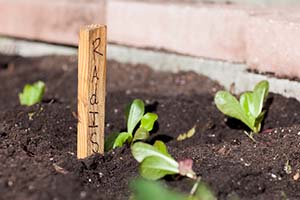Radishes
If you’ve never grown vegetables before, radishes are a fun and easy way to get started.

Photo by Lance Cheung, USDA.
Radishes are also a great crop to grow with kids. They germinate quickly and reach harvestable size within weeks. And don’t let memories of their sharp taste deter you; radishes come in many flavors, shapes, sizes, and colors.
Characteristics
Radishes (Raphanus sativus) are a member of the Brassicaceae family. They are a close relative of cabbages, turnips, and mustards. In form, radishes most closely resemble turnips. The round root grows at and below the soil line and is topped with a small bunch of green leaves.
Radish roots can be white, red, pink, purple, yellow, green, and even black. Most are round and no more than an inch in diameter. Some varieties, like daikon radishes, are elongated and can be up to 20 inches long. The root is crunchy, crisp, and usually white inside.
The entire radish plant is edible. Young radish greens are edible and tasty, fresh or cooked. Older greens are tougher and often have a peppery taste. Both the root and the greens become tough and bitter as they mature, especially in hot weather.
UF/IFAS recommends a number of radish varieties for Florida. ‘Cherry Belle’ radishes are round, bright red, and relatively sweet. ‘Sparkler’ radishes are speckled with white and red, and are on the sweet side, too. ‘White Icicle’ is white, carrot shaped, and fairly mild in flavor. ‘Champion’ is a round, red, heirloom variety with a more traditional radish taste. Look for daikon or Chinese radish varieties if your goal is high production.
Planting and Care

Radishes prefer cooler temperatures. In fact, the bitter, peppery flavor some radishes develop is strongest when they’re grown in warmer temperatures. In Florida, the best time to grow this vegetable is September through March. Most radish varieties can tolerate cooler temperatures and will survive a freeze. They grow best in loose, evenly watered, pH-neutral soil.
Because of their small size, radishes are an ideal container garden crop. They can also be interplanted with slower-growing vegetables, like carrots. Start by sowing the tiny seeds in rows directly into the soil. The seeds should be no more than one quarter inch deep. You can sow seeds every few weeks to ensure a continuous harvest. We do not recommend transplanting radishes. Doing so disturbs the growing root.
Once the seeds sprout, thin the seedlings as instructed on your seed packet. Harvest radishes on the younger side, 20-30 days after sowing. Larger varieties may take longer to develop. Daikon radishes, for example, should be harvested after seven weeks in the spring or after ten weeks in the fall. Whichever variety you choose, don’t allow your radishes to over-ripen; they will become tough and bitter.
Radishes are vulnerable to many of the same pests and diseases as other members of the cabbage family. Whiteflies, aphids, mites, caterpillars, nematodes, and root rot occur occasionally. Check for pests each time you water and you’ll stay ahead of these easily.
Growing Radishes with Children

Sweet radish varieties are more likely to appeal to kids. Picky eaters are more likely to enjoy food they’ve grown themselves, too. Roasting can sweeten the radish flavor and remove some of the bite. Paper thin, colorful slices, artfully arranged, are also exciting to kids. To encourage children to eat new foods, use neutral words, like “pink” and “crunchy,” to describe them.
Whether or not children appreciate the flavor of radishes, most enjoy the planting process. With a little assistance, children ages 3-4 can experience the feel of the potting soil and watering. Ages 4-8 will like to watch the seed leaves emerge and can keep track of how many have sprouted. Children as young as 6 years old can be trusted to follow a watering schedule, with reminders. Older children may want to experiment by varying the growing conditions and managing their own planting. And, of course, gardeners of all ages are proud to harvest and cook their own crops.
For more on radishes and gardening with children, contact your county Extension office.
